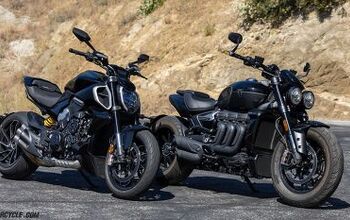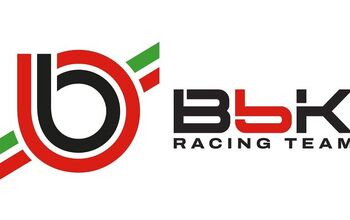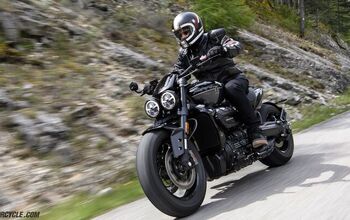2024 Ducati Diavel V4 vs Triumph Rocket 3 Storm R – Side by Side

A celebration of strange, confusing, excessive – and oh-so-glorious motorcycles
Evans warned us this wasn’t a good idea. Having just ridden the Ducati Diavel V4 at its press intro, he knew right away a Triumph Rocket 3 had no business being lined up next to it. Naturally, he shot the idea down when Ryan and I proposed it originally. We moved on to other things, but we couldn’t shake the thought of putting the two bikes together someday. Well, that day has finally come. The Rocket 3, with its gargantuan engine, and the Diavel V4 – the love child of a Panigale and a cruiser – have come and gone through the Motorcycle.com gauntlet. The result may not surprise you…
Evans was right all along.
2024 Ducati Diavel V4 vs Triumph Rocket 3 Storm R
What we thought was going to be two comparable muscle cruisers turned out to be a wildly different affair. The Ducati Diavel V4 and Triumph Rocket 3 don’t fit neatly inside any predetermined category. That’s exactly why we brought them together, but it’s also why they can’t be compared to one another.
Ducati Diavel V4
Highs
- Killer V4 engine
- A sportbike with an identity crisis
- Equally at home carving canyons or cruising along the highway
Sighs
- The 240 rear tire makes handling a little sluggish
- You’ll scrape the pegs down if you forget this isn’t a Panigale
- Wouldn’t a Streetfighter, or even Multistrada, be better for the job?
Triumph Rocket 3 Storm R
Highs
- Killer Triple
- Oozes cool
- You really have to ride one to understand
Sighs
- She’s heavy
- Handles like a boat
- Small people might not agree with the ergos
You see, the Triumph is the definition of a power cruiser. It’s 2.5-liter Triple belches more air than my car, and has the power and torque figures to back it up, easily scooting its 701 pounds down the road without a problem. Those numbers, in case you’re wondering, are 150 horsepower and 148 lb-ft – to the back tire. When was the last time you saw a motorcycle pump out nearly as much torque as it does horsepower?! The truth of the matter is, neither Ryan nor I had ridden any iteration of a Rocket 3 before and we really had the itch. We just had to think of something to run it against.
The Diavel V4 was the best we could come up with. The closest thing Ducati makes to a cruiser, the Diavel is just as much of an oddball in the moto landscape as the Triumph. It sorta resembles a cruiser, it sports a 240-section rear tire like the Triumph, and even though its 1158cc V4 is significantly smaller than the Triumph, it still packs a big punch out of those four exhaust tips – 140 horses and 79 lb-ft, also to the tire. It made sense in our heads, despite the mental images of Evans wagging his finger at us. Alas, temptation was too much to resist.
A Celebration of the Odd, Quirky, and Excessive
Why was Evans right? Because these two bikes are nothing alike, and we realized that within minutes of riding them together. The Triumph is significantly heavier, longer, and more sluggish in comparison. The Diavel, meanwhile, behaves as though nobody told it it wasn’t a superbike. It wants to rev and it likes being tossed into corners. Typical Ducati. As a bonus, it’ll also take you comfortably down the highway with its cruise control.
The difference between the two was so vast, and yet our smiles on each one were so big, we had no choice but to pivot. Instead, this became a celebration of two genre-smashing motorcycles that defy traditional categories and forge their own path. Because, really, who stuffs a giant car engine and a high-revving V4 into a bunch of “cruisers”? With that, let us tell you why the Triumph Rocket 3 and Ducati Diavel V4 are smile-inducing fun machines and why Ryan and I are glad we got these two together after all.
Triumph Rocket 3
This is one of those bikes where the numbers really tell a lot of the story. Starting, of course, with the engine. At 2.5 liters (well, technically it’s 2,458cc), each one of the three cylinders is 820cc! Imagine that – a single cylinder on the Rocket displaces more air than most complete motorcycle engines. It’s absurd. Triumph claims 180 horses and 166 lb-ft at the crank, so when you factor in a 15% driveline loss on the dyno (and the fact it was a hot day), the 148.7 horses it put down to the tire is within reason.
But this engine isn’t about horsepower. It’s a torque monster, with 143 lb-ft coming at a low 3,900 rpm. This is an engine for the lazy, since it doesn’t matter what gear you’re in, once you decide it’s time to go, simply twist your wrist and blast off. Here’s the thing about the Rocket though – it embodies the cruiser attitude. At nearly 90 inches from tip to tip, it’s a long bike. Not only is it long, it’s heavy, too! At 701 pounds on the MO scales, you feel that heft all over, especially when you’re picking it up off the sidestand. It also wears a 240 rear tire and a 150 front. Like steering a boat, you need to plan your turns ahead of time, don’t rush anything, and smoothly bend the bike into corners. Needless to say, the Rocket isn’t made for corner carving. However, should you decide to combine lean angle with heaps of throttle, Triumph were smart enough to equip the bike with lean-angle sensitive traction control.
“I have no acceptable excuse for having not ridden a Triumph Rocket up to this point,” says Ryan. “The only solace in my embarrassment came when Troy, who is much older and has been in this game longer, mentioned that he too was having his Rocket-riding cherry popped right alongside me. There is no other motorcycle that I’ve ridden that delivers the experience of the Rocket 3 Storm R. And although the experience is certainly the sum of the Rocket’s parts, it’s the massive Triple that shines through the Storm. Controlling three pancake-sized pistons with a well-metered right grip that sends planet-rotating torque through a massive shaft-driven rubber hoop at your rear is addicting. Surfing the tidal waves of torque is best enjoyed smoothly, rather than aggressively – though, with the R, it can goad you into bouts of hooliganism. The way the motorcycle rises – thanks to the shaft drive/linkage setup – when you hammer the throttle adds to the wholly unique experience.”
What it is well suited for is cruising. Low and slow, as the saying goes, and the Rocket is in its element. Hum along at whatever speed you want, keep the engine spinning above 2000 rpm, and the Rocket is happy. And really, we were happy. There’s no need to rev the engine out, and if you do, you’ll come up on its 7,000 rpm redline real quick. You need to adjust your brain to shift much earlier, but thankfully clutch pull isn’t too bad. For my 5-foot, 8-inch frame, the seating position had me feeling like a sail at 80 mph. The fat bars are relatively wide, which then splays your arms out. Thankfully, the bolstering at the back of the seat helps keep the rider in place, but it reiterated where the Triumph’s sweet spot is – slowing the pace down.
One of the freedoms you have as a designer when you’re not worried about weight savings is coming up with quirky solutions to things. Take the Rocket’s passenger pegs for example. The two-piece design first hinges from the subframe before it hinges again to reveal the passenger peg. When it’s all folded up, it fits so neatly within the bodywork that it’s easy to miss.
Adds Ryan: “From the passenger footpegs, to the shock linkage design, the Rocket 3 hides tastefully unique engineering surprises throughout its massive frame. The fit and finish of the entire bike is absolutely top-level, and in my opinion, a cut above the $2,000 more expensive Diavel.”
The Rocket wears adjustable Showa suspenders at both ends. Both have compression and rebound adjustments, but only the rear allows you to change your preload with the convenient knob. Our test bike was delivered with the rear preload nearly all the way in, so backing it out balanced the ride between front and back. If we were to nitpick, the initial bump absorption is too abrupt for our taste, but once the valving opens up, the suspension and the spring rates seem to be a good compromise between comfort and performance – with a slight bias towards comfort.
With so much power and weight, it’s a little weird the Rocket “only” wears 320mm discs up front, but at least it’s paired with Brembo Stylema calipers. Braking performance is actually decent, all things considered. If you really need to stop in a hurry, well, you’re hosed. But, to slow down faster, the rear disc is 300mm and is clamped by a Brembo M4.32 monobloc caliper – the same one you see on the front of many motorcycles. Should you get overzealous with the brake levers, the Rocket’s IMU is the brain behind the cornering-ABS.
“The Rocket 3’s front tire is the same diameter as the rear tire on my KTM 890 Adventure R,” Ryan says. “And yet, somehow, the machine is surprisingly nimble for such a leviathan.”
Triumph says the Rocket is rated at 43 mpg. Our mixed testing of highway miles and canyon roads is anything but ideal conditions for conserving fuel, but we still managed 31.2 mpg from the huge Triple.
Ducati Diavel V4
This is where things get funny. If you want a quick summary about the Ducati, take everything above about the Triumph and the Diavel is the opposite. Allow me to explain. The Diavel V4, like the Rocket 3, is highlighted by its engine. In this case, the high-revving 1158cc V4. You know it first from the Panigale and Streetfighter, then later in the Multistrada. The engine makes sense in all of those applications. But this? Since its inception, the Diavel has always been about being a muscle cruiser, and in that sense the V4 seems appropriate, but the more we rode the Diavel, the more we started to move away from the muscle cruiser theme and entered into standard bike territory (which is exactly what Evans concluded in his First Ride). The point is the lines are blurred, we don’t really know where either bike belongs, but we do know the Diavel V4 is a raging bull. Which is why we also like it.
On the dyno, the Diavel spun the drum to the tune of 138.5 horses. This is only 10 horses less than the Triumph, but it comes at 10,300 rpm versus the Triumph’s 6,800 rpm. The Ducati also benefits from a 178-pound weight advantage (523 lbs vs. 701 lbs), so it’s no surprise to see the Diavel rocket away in a drag race (pun intended). The included quickshifter and autoblipper on the V4 further helped it pull away in the drags, as each time the Triumph rider had to momentarily release the throttle to upshift, the Ducati would pull a gap.
Ryan adds: “The Ducati’s engine is unequivocally of the sporty variety, which of course is spot on for the Italian marque. Despite being tuned to deliver more low-rpm torque in its Granturismo trim, next to the Rocket, it feels like a slightly more relaxed Streetfighter V4… because it is, basically. Quick pops from the quickshifter add to the experience that this machine is much more naked bike than cruiser, muscle or not. The addition of rear cylinder deactivation also helps to quell Ducati’s stereotypical heat issues with this mill, too.”
Considering its lineage, it should come as no surprise the Diavel feels like a sportbike trapped in a…well…we don’t really know what body it’s trapped in. What we do know is that the Diavel likes to run and it wants to be revved. Like we said, it’s the opposite of the Triumph. You sit low in the Diavel, at just 31.1 inches, while the bars are relatively high with good spacing between the hands. It’s an unusual feeling for a Ducati, but it’s comfortable. Both bikes share a 240 rear tire, but the Ducati’s 120/70 front highlights how much more agile and nimble the Diavel is in comparison. Unsurprisingly, the Diavel can carve a corner better than a bike that looks like this probably should. You’ll still find the limits and drag hard parts much faster than a Panigale, and the 240 rear does make direction changes a little sluggish in the overall scheme of things, but a competent rider on one of these could really embarrass some wannabe hot-shots on the local hill. And unlike those hot-shots, the Diavel has cruise control, so you can roll down the highway and be fresh by the time you get to the twisties. For me anyway, I wasn’t splayed out like a sail on the Diavel, either.
Ryan notes, “As Troy alluded to, the wheel sizes cause the Diavel to exhibit some funky handling traits. Through fast sweeping corners, and most general riding, the Diavel handles fine, but when hustling through a tight section of canyon roads – something the bike is all too willing to do, the pairing of a standard sporty front wheel with the gargantuan 240-section rear delivers an awkward mismatched feeling. That said, it still easily left the Rocket behind – particularly quickly in the tighter stretches. Shocking, I know.”
Being a Ducati, you expect the Diavel to come packed with electronics. It’s become commonplace now. Like other top-shelf Ducs, you’ll find cornering ABS, lean-angle sensitive traction control, and wheelie control, just to name a few. There are also the customary riding modes, too. What was interesting was that, for overall riding, both Ryan and I preferred the slightly more mellow throttle response from Touring compared to Sport. Sport was a little too snappy for our taste, even on the fun roads. Meanwhile, we had the Triumph’s throttle set to its most aggressive but it was anything but.
You’ll find fully adjustable suspension on the Diavel, but that’s a bit misleading as the compression adjustment for the shock is so hard to reach you’re tempted to leave it alone. Ultimately, our test bike rode slightly harsh in the rear despite the minor tweaks we made. Stopping power comes from Brembo Stylema calipers, just like the Triumph, but the Ducati wears 330mm rotors up front. As you’d expect, the bigger brakes and the lighter weight allow the Diavel to scrub speed fast. That said, we liked the brake feel at the lever from both bikes. Maybe not much of a surprise considering how much higher it revs, but the Diavel returned a slightly worse mpg number than the Triumph, at 30.6. Still not bad for how much we let it sing.
“From a floppy rear seat cowl, to a missing fastener on a plastic side cover, the Ducati didn’t impress in the fit and finish department,” Ryan says. “Perhaps this press fleet damsel had been abused by rations of careless influencers and journalists, or maybe it was just riding it alongside the aristocratic Rocket that made it pale in comparison. It’s subjective, but I’m also really not a fan of the faux engine covers.”
Different Strokes For Different Folks
At $27,000 for the Ducati and $25,000 for the Triumph, there’s hardly anything in it when it comes to pricing, so this truly comes down to which flavor you like better. I thought the Ducati would be my flavor since it’s basically a comfortable sportbike with a ground clearance problem. And while I enjoyed the experience of riding it, I couldn’t help but think the Streetfighter V4 is nearly the same tool without the limitations.
Ryan agrees: “Troy hit the nail on the head for me with the Streetfighter/Diavel comparison. We talked about it during our ride. If I were shopping the Ducati lineup, the Streetfighter V4 would easily win me over because it doesn’t have the limitations of the Diavel. There is also the fact that the bike has now morphed from a more ‘traditional’ muscle cruiser in the XDiavel, to what is now much closer to a naked bike, or to use the term that Ducati coined and Evans’ accepted, a Mega-Monster. Despite being loads of fun to ride, I can’t help but feel like the Diavel V4 is having a bit of an identity crisis. I’ll accept whatever it identifies as, I’m just not sure it’s decided yet.
Coming full circle, I can’t believe it’s taken me this long to pilot Triumph’s monstrous Triple. I’m sure this is by far the most refined, highest performing iteration yet, but the unique experience that is the Rocket is completely unparalleled by anything else on the market – in the best way. Had Troy not lost the key (key fobs *insert eye roll*, am I right?!) during our last ride, I would have opted to take the Triumph home to spend a few more days with the bike before returning it.”
The Triumph is something all its own. It sounds crazy, but to me, this is closing in on what the cruiser experience is all about. It does “low and slow” with the best of them, but when it’s time to move, you better hang on. Not only does the torque win hearts, but when you step off the bike, you can’t help but give it a double take. I know beauty is subjective, but I really do think it looks good. Yes it’s heavy and the handling doesn’t compare, but who cares? The Rocket 3 is cool, it has a personality (not that the Ducati doesn’t), and it was one of the few bikes I was sad to give back. Now I know why it’s been around for so long.
Troy's In Gear

- Helmet: Arai Regent-X
- Jacket: Alpinestars SMX Air
- Airbag: Alpinestars Tech-Air 3
- Gloves: Alpinestars Phenom Air
- Pants: REV’IT Davis TF
- Boots: Alpinestars Superfaster
Ryan's In Gear

- Helmet: AGV K6 (discontinued)
- Jacket: REV’IT! Mantis (discontinued)
- Gloves: REV’IT! Prime (discontinued)
- Pants: Pando Moto KarlDo Kev 1
- Boots: REAX Fulton Air
Scoreboard
Ducati Diavel V4 | Category | Triumph Rocket 3 Storm R |
92.6% | MSRP | 100.0% |
100.0% | Weight | 74.6% |
100.0% | Pounds/HP | 80.3% |
73.8% | Pounds/Torque | 100.0% |
93.2% | Total Objective Scores | 88.3% |
95.0% | Engine | 97.5% |
95.0% | Transmission | 85.0% |
80.0% | Handling | 72.5% |
90.0% | Brakes | 82.5% |
85.0% | Suspension | 85.0% |
90.0% | Technologies | 87.5% |
92.5% | Instruments/Controls | 90.0% |
90.0% | Ergonomics | 85.0% |
80.0% | Quality | 95.0% |
85.0% | Cool Factor | 92.5% |
90.0% | Grin Factor | 95.0% |
89.8% | Overall Score | 88.7% |
Specifications | 2024 Ducati Diavel V4 | 2025 Triumph Rocket 3 Storm R |
|---|---|---|
MSRP | $26,695 (red), $26,995 (black) | $24,995 |
Engine Type | 1158 cc liquid-cooled Granturismo, V4 – 90°, 4 valves per cylinder, counter-rotating crankshaft, Twin Pulse firing order | 2,458cc liquid-cooled, Inline 3-cylinder, DOHC |
Bore and Stroke | 83 mm x 53.5 mm | 110.2 mm x 85.9 mm |
Compression Ratio | 14.0:1 | 10.8:1 |
Horsepower | 138.5 hp @ 10,300 rpm (as measured) | 148.7 hp @ 6,800 rpm (as measured) |
Torque | 78.7 lb-ft @ 8,700 rpm (as measured) | 142.8 lb-ft @ 3,900 rpm (as measured) |
Fuel System | Bosch electronic fuel injection | EFI |
Clutch | Multiplate wet clutch with control and slipper function. | Wet, multi-plate, hydraulically operated, torque assist |
Transmission | 6 speed with Ducati Quick Shift up/down | 6 speed constant mesh |
Final Drive | Chain | Shaft drive, bevel box |
Frame | Monocoque aluminum alloy | Aluminum |
Front Suspension | 50 mm fully adjustable usd fork; 4.7-in travel | Showa 1.9” (47mm) upside-down 1+1 cartridge front forks, compression and rebound adjustment, 4.7” (120mm) wheel travel |
Rear Suspension | Fully adjustable monoshock, aluminium single-sided swingarm; 5.7-in travel | Fully adjustable Showa piggyback reservoir RSU with remote hydraulic preload adjustment, 4.2” (107mm) wheel travel |
Front Brake | Dual 330 mm semi-floating discs, radially mounted Brembo Stylema monobloc 4-piston callipers, radial master cylinder PR16/19, Cornering ABS | Dual 320mm discs, Brembo M4.30 Stylema 4-piston radial monobloc calipers, Optimized Cornering ABS |
Rear Brake | 265 mm disc, Brembo 2-piston floating calliper, Cornering ABS | Single 300mm disc, Brembo M4.32 4-piston monobloc caliper, Optimized Cornering ABS |
Front Tire | Pirelli Diablo Rosso III, 120/70 ZR17 | 150/80 R17 |
Rear Tire | Pirelli Diablo Rosso III, 240/45 ZR17 | 240/50 R16 |
Rake/Trail | 26/4.4 inches | 27.9°/5.3 inches |
Wheelbase | 62.7 inches | 66.0 inches |
Seat Height | 31.1 inches | 30.4 inches |
Curb Weight | 523 pounds (as measured) | 701 pounds (as measured) |
Fuel Capacity | 5.3 gallons | 4.76 gallons |
Fuel Mileage (observed) | 30.6 mpg | 31.2 mpg |
Electronics | Full-color 5" TFT display, Ducati Media System, selectable ride modes, cornering ABS, cornering traction control EVO 2, wheelie control, launch control, Ducati Quick Shift up/down EVO 2, cruise control, and all LED lighting. | Full-color TFT instruments, Optimized cornering ABS & traction control – supported by an IMU, 4 riding modes, all LED lighting, Hill hold control, Cruise control, Keyless ignition, Backlit switchgear, USB charging, Heated grips |
Colors | Ducati Red, Thrilling Black | Carnival Red with Sapphire Black, Satin Pacific Blue with Matte Sapphire Black, and Sapphire Black with Granite |
Warranty | 24 months, unlimited mileage | Two-year unlimited mileage |
We are committed to finding, researching, and recommending the best products. We earn commissions from purchases you make using the retail links in our product reviews. Learn more about how this works.
Become a Motorcycle.com insider. Get the latest motorcycle news first by subscribing to our newsletter here.

Troy's been riding motorcycles and writing about them since 2006, getting his start at Rider Magazine. From there, he moved to Sport Rider Magazine before finally landing at Motorcycle.com in 2011. A lifelong gearhead who didn't fully immerse himself in motorcycles until his teenage years, Troy's interests have always been in technology, performance, and going fast. Naturally, racing was the perfect avenue to combine all three. Troy has been racing nearly as long as he's been riding and has competed at the AMA national level. He's also won multiple club races throughout the country, culminating in a Utah Sport Bike Association championship in 2011. He has been invited as a guest instructor for the Yamaha Champions Riding School, and when he's not out riding, he's either wrenching on bikes or watching MotoGP.
More by Troy Siahaan










































Comments
Join the conversation
Ever since its first presentation l thought the rocket 3 should have the fuel tank under the seat and the air filter above the engine.
I don't know this would seem right I believe.
Thankfully Evans didn't get to squash this again. Comparisons don't always need to make sense. Motorcyclist doesn't necessarily make sense. And our choice of motorcycle(s) is often based on emotions rather than what makes sense. Great comparison. I'd love to have either bike or both.